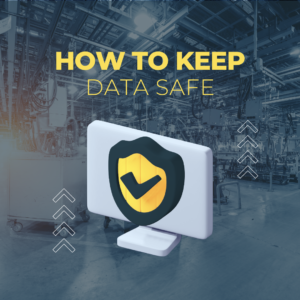How to Keep Data Safe
This short blog is about how to keep data safe and managing safety risk in the cloud with proactive solutions.
Companies that have moved business to the cloud and those that have watched have both learned valuable lessons in the transition. These lessons have been brought on by a lack of planning, misunderstanding of data migration and unforeseen cyber attacks. On average, there is one cyber attack every 40 seconds! These costly mistakes are easily avoidable by taking necessary steps to ensure data safety during migration or ordinary technology processes. Businesses attribute billions of dollars in losses to security breaches, stolen information and other espionage activities. Moving business processes to the cloud is an advantage with its ease of access and mobility, but still opens new doors for hackers and security threats.
Here are some of the top ways to keep data safe and compliant while continuously improving processes:
- Establish Multiple Data Backups
- Encrypt Data
- Enforce Strict User Permissions
- Secure User Devices
- Continuously Test & Improve
Establishing Data Backups
While many businesses are adequate or advanced in storing company information, sometimes technical issues and user error can occur, thus wreaking havoc on IT infrastructure. This is why it is crucial to acquire multiple backups of your data. Losing data or important information from a glitch or technical error can be frustrating, but preventable. By having multiple, safe backups of company data, the unknown of where data disappears is solved. Many cloud-hosting services already carry backups of your data or offer safe methodologies for you to store data copies of your own.
Storing multiple copies will ensure compliance, security and productivity when it comes to utilizing data later on. It is very important for manufacturers to continually have access to the right information at the right time, especially in the time of a crisis. Backing up your files or creating solid record-keeping is a great way to keep your organization running smoothly and customers happy.
Encrypting Data
Sometimes it is a positive to send cryptic messages, as long as it’s to the hackers or malicious malware attempting to perform a cyber attack. Encryption is the encoding of information to secret codes or text, therefore transforming data into an unfamiliar language to hackers or malware. This practice is one of the safest ways to protect private information and makes it very difficult for hackers to access private information. Encryption is available for virtually any type of information from general emails to compliance data.
Setting User Permissions
Strict user permissions is a great way to limit the number of ‘oopsies’ that occur with private information. Many times, employees or users of systems only need access to a fraction of the access that they have. Minimizing access to certain data or data management processes can improve data safety and ensure that users cannot make any costly mistakes with the information. If possible, implementing a system of accountability that shows user actions with your organization’s data can keep you on top of information changes and current user responsibilities.
Securing Devices
Each device that is used for data collection, migration, management or review is susceptible to an attack. By utilizing tools like a Firewall or VPN (Virtual Private Network), it prevents any suspicious malware or internal threats from accessing these devices. Whether a smartphone, tablet or computer, there are risks to using each of them and can be prevented with the right methodologies. Device security can be improved by continually changing passwords, enabling multi-factor verification and having full administrative access to manage all user accounts or devices.
Testing and Improvements
Continuously monitoring data safety activities and being proactive about data safety can ensure long data life and usability. One of the best ways to continually improve information systems security is to hire cyber attackers (professionals) that can present current vulnerabilities in computer networks or systems to offer recommendations of solutions.
Sometimes, not all data is needed; high-quality data can be hard to come by and aggravating to retrieve through all the organizational data noise. Disposing of old, useless data can keep networks running smoothly and improve accessibility to the right information. Out of the many ways you can take action now, beginning with testing and staying committed by continuously finding new ways to improve data safety are top ingredients for security success.
Don’t become another cyber attack statistic, finding ways to keep data safe doesn’t have to be a struggle. With resources that empower businesses with proactive tools, it is up to the business to implement winning safety strategies that set them apart from the competition. To find more ways you can keep information safe and secure, please submit an inquiry here to receive a comprehensive list of safety vulnerabilities.
